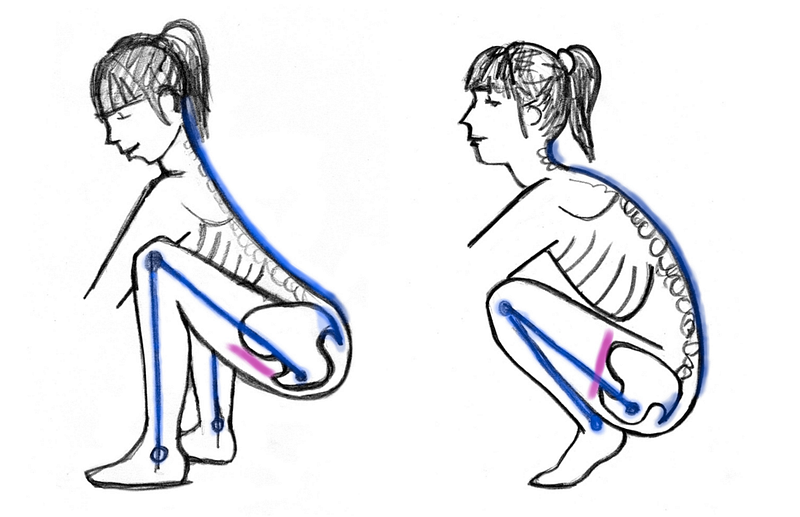


Images from “OVERGROWTH.” © Parker Fitzgerald and Riley Messina/Ransom Limited
This content shows Simple View
I’ve recently been introduced to the teaching of Diane Bruni by Rachel Johnston (who provides endless movement and teaching inspiration, and reminds me to keep questioning everything!) Diane has these wise words on her website:
‘WHAT ARE WE ACTUALLY TRAINING INTO OUR BODIES?
This is a question I ask every time I practice and teach. If what we’re training into our bodies does not enhance the movements of daily life, why would be practice them? Why not practice the poses and movements that will reinforce the patterns that we were designed to move in. Instead of standing on our heads and risking neck injury, why not learn to walk well? Instead of forward folding with straight legs and putting strain on the lower back why not learn to squat well? The list goes on.’
What I teach is not static or set in stone. I don’t stick to one ‘system’ and I am learning to constantly question and re-question what I am teaching. This means that under the umbrella of yoga, my classes are influenced by anything that has inspired me to move better, and that I want to pass on to others to help them move better and be more aware of their bodies. This can be yoga, or most recently The Feldenkrais Method, Katy Bowman, Gary Ward, and Somatics. This also means a lot of unlearning of things I was previously taught (namely alignment cues, and what I am training into my own body) , things that I had previously never questioned. Rachel Johnston sums this up perfectly (full post here):
‘You as practitioners and we as teachers should never stop questioning and exploring in this kind of work. Half of what we think we know (and teach) is most likely misguided or wrong, and we are never going to find out which half without challenging perceived wisdoms.’
Here’s a more natural way of positioning the hand in Downward dog taken from Diane’s website (you can read Diane’s full ‘hand rant’ here), which challenges the traditional alignment cues given in most yoga classes:
Give it a go and notice if and how it changes the pose for you.


Taken from BODY, 2009 – 2011 by Antony Gormley. Click here for more work.
‘Your joint laxities are affected by how your entire body moves through the entire day, throughout your entire life. By learning how to move your entire body better, and then moving it better, you will see spillover into areas you didn’t imagine could be related to how you move.’ Katy Bowman
‘Our bodies are beautifully plastic and can adapt to our lifestyles and compensate for our postural habits in a variety of ways. Similarly they can gradually grow into a better alignment if we find our own space for expansion through movement, the space to grow into.’ Full article here
‘Even though we now have only the beginning of what was once a real mammalian tail, it behaves the same. Untucking the tailbone opens the pelvic outlet, tucking it closes it — tightening the pelvic floor. The dog with his tail down between his legs is an equivalent of you sitting on your sacrum, the back supported by a chair or a couch. If you spend multiple hours a day in this position, your pelvic floor doesn’t really have a chance to release and allow the muscle fibres to regain their natural length at resting state. So gradually it shortens.’ From Yoga with Ivana blog

Really interesting article from Katy Bowman on the relationship between how you eat with how you move:
‘In the natural world, how you eat is based on your ability to get and prepare your food. By being directly involved with your food at every step throughout your life, you maintain the skills and physique necessary to continue to eat. In the natural world, you eat how you move...Historically the work (forces created by human movement) necessary to eat included not only the hunting and gathering bit, but also the mashing, banging, rubbing, beating, tearing, pounding, soaking, spreading, turning, hanging that it took to make nature edible. Said another way, most of the food you use to make your meals–even the “whole ingredients” like nut and coconut flours, oils, milks, and syrups you pour with ease, meats cut with precision, and veggies clean and separated for your convenience–has been processed. Not like in the “I just made this food by putting different chemicals together” kind of way, but a “hey, we performed 14 hours of labor so you could have these whole foods to now cook for your meal, you’re welcome,” kind of way.’ Full article here
Having spent basically a whole day trying to make apple juice from scratch, my movements included picking, pounding, pouring, grinding, pressing, lifting, among other less violent ones. I could have bought the apple juice and saved myself a lot of time, but when looked at from a movement perspective, if I had just skipped to the end bit, my movements would have probably just been pouring and sipping.
Here’s a couple of foraging recipes I’ve tried recently:
Hawthorn fruit leather

Ingredients: 1/2 litre hawthorn berries (you can add any hedgerow berries like sloes and rose hips- just improvise, but make sure you use approx half the volume of water to fruit.), 2 dessert apples (chopped), 1/4 litre water.
Method: put all the ingredients in a pan and bring to a slow simmer for 15 mins. Mash with a potato masher then rub through a coarse sieve onto a parchment-lined baking tray (approx 25 x 35cm). Spread out evenly with a spatula then put in oven at the lowest temp until dry. In a fan oven this may take around 3-4 hours. Or use a dehydrater if you have one. Discard the parchment paper, cut the fruit leather into strips and store in an airtight container.
Recipe from Native Hands
Nettle soup
Ingredients: Half a carrier bagful of stinging nettle tops, or fresh-looking larger leaves, 50g butter, 1 large onion finely chopped, 1 litre vegetable stock, 1 large potato, peeled and cut into cubes, 1 large carrot, peeled and chopped,sea salt and freshly ground black pepper, 2 tbsp crème fraîche, a few drops of extra-virgin olive oil, a few drops of Tabasco.
Method: Wash the nettles and drain in a colander. Melt the butter in a large saucepan, add the onion and cook gently for 5-7 minutes until softened. Add the stock, nettles, potato and carrot. Bring to a simmer and cook gently until the potato is soft, about 15 minutes. Remove from the heat. Purée the soup and then season with salt and pepper to taste. To serve add a teaspoonful of creme fraiche on top. As this melts, swirl in a few drops of extra-virgin olive oil and Tabasco.
Recipe from River Cottage
‘The long body is a Native American term which refers to the individual body plus the life support systems around it. It is a much bigger conception of the human body than we have in western culture, and considers the body continuous with the larger environment.’
I’ve been working my way through the excellent Liberated Body podcasts. This is one of my favourites so far- Frank Forencich talks about the importance of slowing down, getting outside, and putting down the phone. Here’s the podcast and here’s Frank’s article Habitat is Tissue.